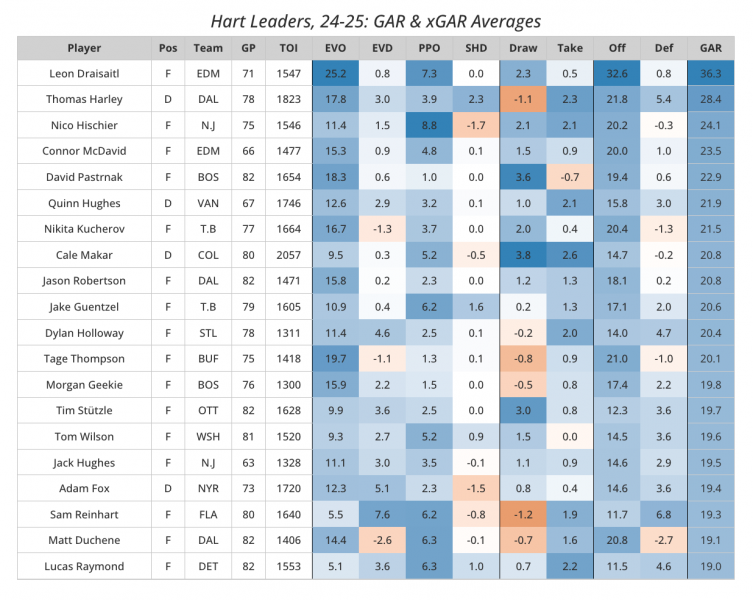Over the past 7 years, throughout the NHL season, I (Luke) have posted my picks for the NHL Awards based on our GAR & xGAR metrics on Evolving-Hockey (without any further explanation). Short-form social media is not a great place to post detailed explanations of this methodology, and this year I figured it would be a good idea to write a proper article explaining my process (and our picks for this year’s NHL Awards). After a few attempts at doing this myself, I decided I’d ask my brother to help since he is much better at writing things than I am. So, we have another Evolving Hockey Staff article, but it’s the rare version that includes both Twins writing and not Shawn. What a special event.
There are multiple ways one could approach ranking players for the awards given the numerous metrics available. I’ve always tried to keep our process as simple and objective as possible – I use the average of our xGAR & GAR metrics for the Hart & Norris and the average of the xGAR & GAR EVD components for the Selke. The Calder is determined using a z-score transformation of average xGAR & GAR along with rookie goalie GAR (which is the goalie side of the xGAR model – don’t ask me why I didn’t call it xGAR). The Vezina is a simple ranking of total goalie GAR for the given season (again, this is the goalie side our xGAR model). Lady Byng is determined by the leaders in our penalty goals component for GAR/xGAR (the same “model” is used for both systems).
It’s difficult to combine xGAR and GAR with objective “precision”. I’ve used a weighted average in the past, but I figured a simple average would be the least subjective. I normally present our picks in three tiers with a total of anywhere from 6-12 players (the Lady Byng is always extremely close so I only post 5 players) – we’ll be displaying those tiers for each award below. For most awards we’ve limited it to 8 players.
A few notes about the tables in this article:
- “Off” is EVO + PPO and “Def” is EVD + SHD
- “Take” & “Draw” are the penalty goals components of both the GAR/xGAR models
- The conditional formatting is scaled based on the quantile (0%/50%/100%) for each column relative to the respective population. For example, the EVO column for skaters in the Hart table below is shaded from dark orange (0%), to white (50%) to dark blue (100%) for all skaters. Skater awards are based on all skaters in the league, goalies the same.
[Josh typing] We’d also like to take this opportunity to, in print-form on our website that hosts articles, say this: we are not attempting to “predict” who will actually win each award. Our methodology for this exercise has always been to rank players for each award based on who we think is most deserving of said award per the NHL’s definitions. Like our Trade Deadline article (great article by the way, go check it out it’s probably still relevant), our exercise(s) sometimes get dismissed because “that will never happen”, but that’s almost never our point. Do I actually think Zachary Bolduc is going to win the Calder? No. Do I think he should? I mean, maybe – in our opinion he should be in the conversation!
Alright, with that out of the way, let’s properly cover our favorite topic of the year for the first time on Evolving Hockey dot com!
Hart

Tiers
- Leon Draisaitl
- Thomas Harley | Nico Hischier
- Connor McDavid | Quinn Hughes | David Pastrnak | Nikita Kucherov | Cale Makar
Leon Draisaitl’s season has been simply incredible, again. He’s scored 52 goals so far, which is driving quite a bit of his offensive value in our xGAR model (it’s hard to score that many goals and not be among the league leaders in a model that includes a component similar to goals scored above expected). But he hasn’t really been that bad in any other component – his defense is below average but it’s nothing terrible. Draisaitl’s is on pace to finish among the top-5 single skater seasons since 2007 in xSPAR. There’s really not much else to say except I kind of wish he was being underrated in the media so we could have a reverse Nichushkin / Draisaitl scenario again. We’ve never doubted Draisaitl.
Thomas Harley is not being talked about enough in our humble opinion – he’s good at everything. I know his performance on Team Canada in the 4 Nations Tournament made some waves, but this dude has been an absolute stud with Dallas for the last two seasons. He is our pick for the 2nd spot in the Hart and, unsurprisingly, our Norris pick. Of note: Quinn Hughes was the frontrunner for this spot up until a few weeks ago. He dropped off somewhat during that time period… There’s only so much you can ask from one skater on the Canucks.
Among the media consensus, Nathan MacKinnon is the obvious missing piece here. 116 points is a lot, but both our GAR and xGAR models seem to attribute the theoretical version of “points” to other players throughout the Avalanche lineup. Based on our methodology, he sits about 35th in this ranking, which is surprising. While points and our GAR/xGAR model duo are often correlated (to an extent), every season we see players like this that stick out. MacKinnon is still the second most valuable player on the Avalanche, he just halved his xGAR from last season. Maybe Rantanen wasn’t entirely carried by MacKinnon after all? Time will tell.
Norris
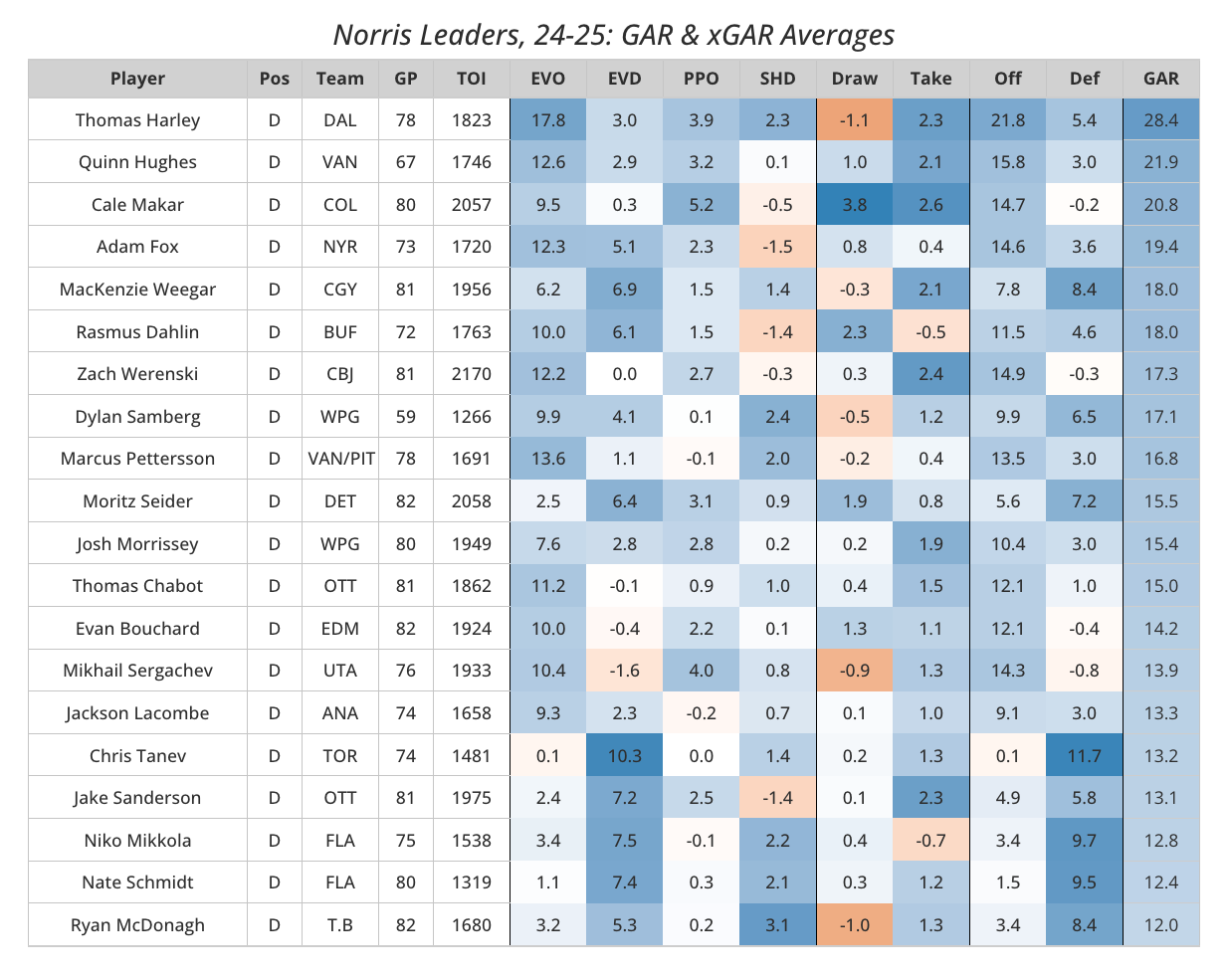
Tiers
- Thomas Harley
- Quinn Hughes | Cale Makar | Adam Fox
- MacKenzie Weegar | Rasmus Dahlin | Zach Werenski | Dylan Samberg
Hughes and Makar have been the consensus contenders for the Norris since December – that’s just how the power of “the narrative” functions. Throw Werenski in the mix, and you get the trio every major media outlet has picked since about January. It’s not always the case, but this year all three of these players are quite deserving based on our methodology (all three are among the top 7 defensemen by our ratings). That said, Thomas Harley is our clear pick for the Norris. After a spectacular season last year and a lot of questions surrounding his bridge deal last September, the Stars may be reconsidering their choice to bridge him. Harley has powered the Stars with a wide range of teammates: his most common defensive partner has been Lyubushkin (only 36% of his EV minutes). Often, defensemen with Hart-level seasons like this generate that value from their shooting, but Harley’s added more value from his even-strength rates per our xGAR model than shooting at all-situations (11.9 / 8.6). Since 2007, Harley is on pace to rank 8th among all defensemen in total xGAR. In this modern era, I can’t overstate how impressive that is. Maybe we should’ve been yelling louder this season.
Also, this list provides several interesting names… Among them, the Jets defensive duo of Dylan Samberg and Josh Morrissey may be the most fascinating. Morrissey is the clear favorite per our xGAR model, but averaging GAR & xGAR raises Samberg above him in the ranking. They’ve played about ~5% of their even-strength time together, so this is a true question with the evaluation methods (collinearity doesn’t factor in at all). As we’ve stated before, our GAR model is not our preferred model for evaluating defensemen due to its usage of on-ice shooting % (it’s a lot more complicated than that, but they’re highly correlated). From the xGAR view, both players are actually quite similar, but Morrissey’s higher on-ice shooting quality (xG) indicates he’s been more valuable to the Jets overall. It’s not surprising a pair of Jets defensemen show up in this list considering the Jets’ season – given how close they are it may require less statistical methods to rank them… Regardless, Harley should win the Norris in our opinion.
Selke
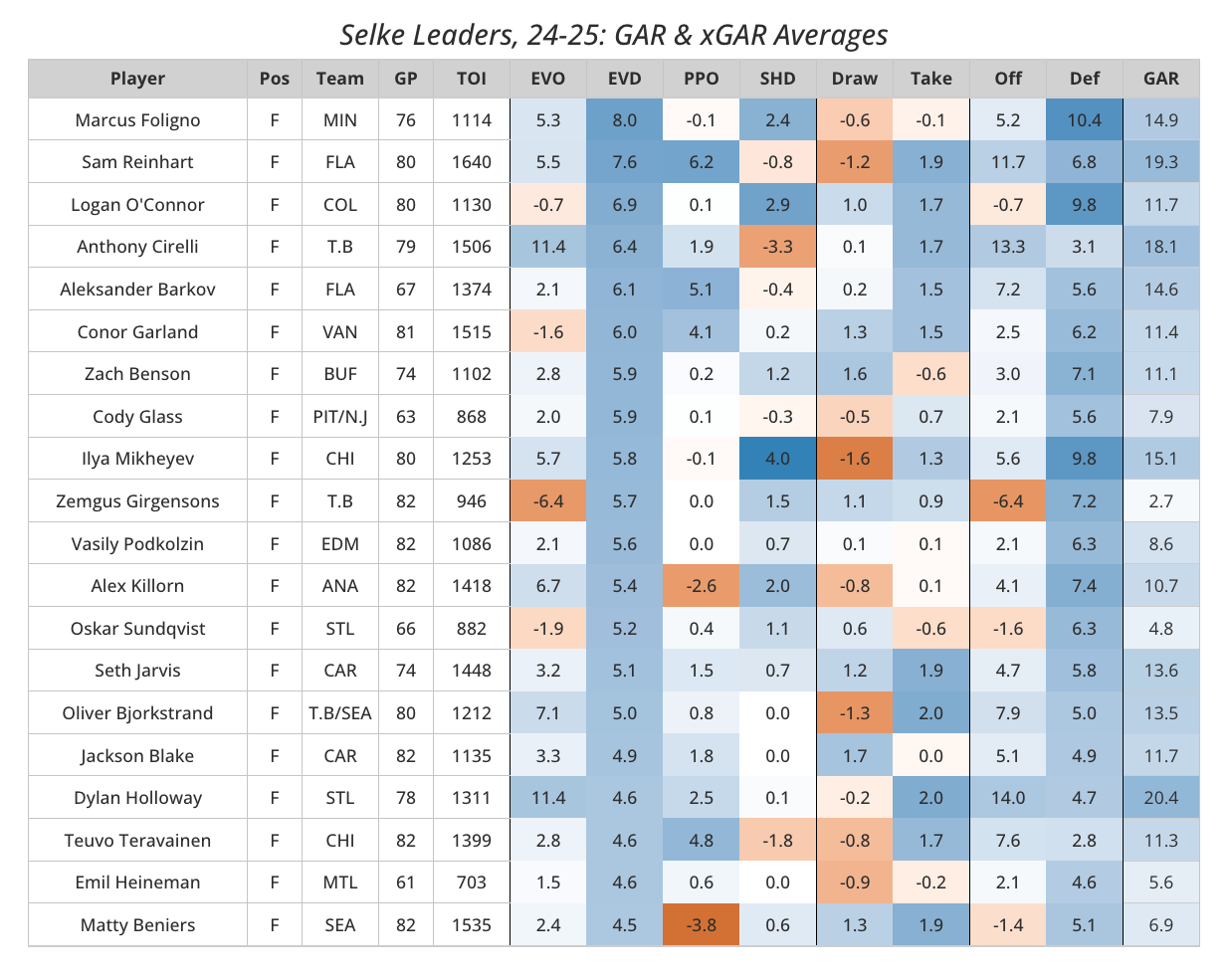
Tiers
- Marcus Foligno | Sam Reinhart
- Logan O’Connor | Anthony Cirelli
- Aleksander Barkov | Conor Garland | Zach Benson | Cody Glass
The Frank J. Selke award. The best award in all of sports. Some may even say it’s the highest honor any individual can receive in any sport.
As you can see, we’ve sorted the forwards by Even Strength Defense (EVD)… If you listened to our podcast from today (The Evolving-Hockey Podcast®, which can be found on most major podcast platforms), you’ll know that we only consider EVD performance in our Selke rankings. Why? Well, killing penalties is significantly more team/system driven than even strength defense, and players do not (usually) get to choose whether or not they are put on the penalty kill (especially if they’re not good at killing penalties but their coach thinks they are). Additionally, we add no arbitrary “top line” or “two-way player” conditions… This is pure defensive play, regardless of a player’s TOI/GP or position in the lineup.
Our pick for the Selke this year is Marcus Foligno. Yes, he is a winger. Yes, he plays a third line role for Minnesota. And, Yes, he has been one of the best defensive forwards in the league for many years… However, he is quite simply very very good at shutting down opposing teams. Additionally, not that it exactly matters in this conversation, his only below replacement season in xGAR EVD was his rookie year and with the infamous ‘14-15 Sabres. Marcus Foligno for Selke 2025.
After that we have Sam Reinhart who is very close to Foligno. Either would be a great choice, but Foligno should win because he’s a winger and I think that would be pretty cool. Logan O’Connor is another winger no one seems to talk about – he’s turned into one of the best defensive forwards in the league with the Avalanche. Like Foligno, O’Connor’s had fantastic defensive results in a depth role (for multiple seasons)… I just think these players are valuable and they deserve some recognition! I love the Selke award. Maybe next year we’ll invent the Tanev/Hjalmarsson/Brodin Award for best defensive defenseman. Everyone would love that.
Calder
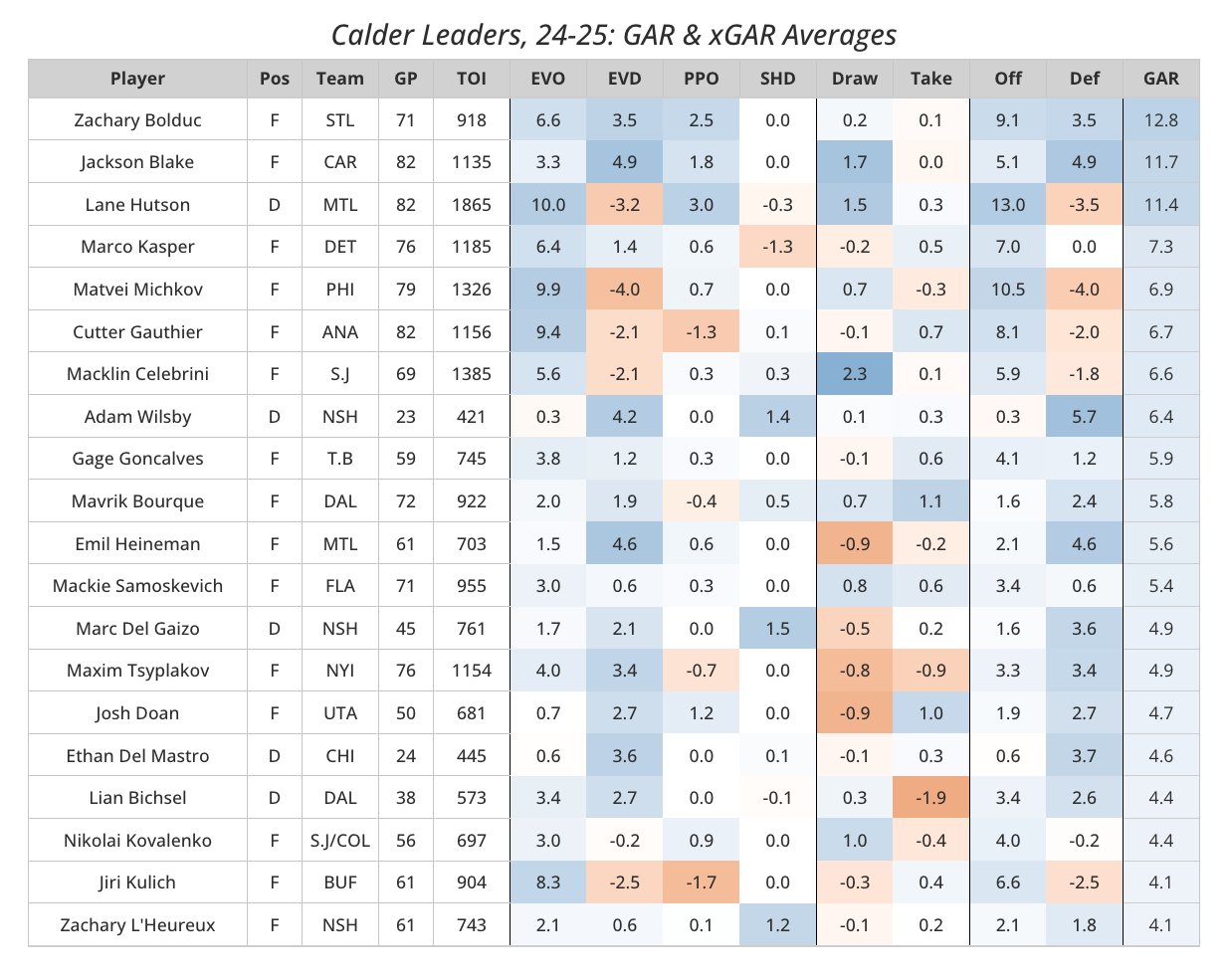
Tiers
- Dustin Wolf
- Zachary Bolduc | Jackson Blake | Lane Huston
- Marco Kasper | Matvei Michkov | Cutter Gauthier | Macklin Celebrini
Last year’s Calder “race” was incredibly boring. Everyone decided Connor Bedard would win it before he even played a game, and they fulfilled that ill-reasoned prophecy. Look, we’re talking about children here, so I don’t want to be too mean. The ‘24-25 season’s provided a nice crop of promising rookies for us to track over the next couple of seasons. And for the first time that I can remember, we’re going with a goalie for this trophy who isn’t even present in this table (we couldn’t figure out a good way to show skater and goalie stats in the same table so I hope people are reading this). Dustin Wolf has been legitimately phenomenal for the Flames. Since 2007, no rookie goalie has really come close to his 31.5 GAR (Stuart Skinner in ‘22-23 with 25.4 GAR and Matt Murray in ‘16-17 with 24 GAR are the most recent examples). That GAR total places him among the top-5 goalies for the ‘24-25 season as well. Historically we tend to favor skaters in our awards picks if things are close for no real reason after much speculation about this (maybe it really is just displaying skaters and goalies together in any visualization). But this season, it’s undeniable that Wolf is the most deserving rookie.
Lane Hutson is the consensus pick, it seems – and for good reason. Given the Canadiens’ surprising rise and likely playoff berth, he’s the clear favorite. However, a certain team out West on a similar playoff run hosts a rookie that’s more our style. Zachary Bolduc came out of nowhere this season; yes, his 15.6% shooting percentage helps here, but as a 22 year-old in his first full season, he’s 5th among rookie forwards in xEVD. Even playing more of a bottom-6 role with the Blues, with no areas below-replacement, this is the kind of young player you keep an eye on. Possibly the most entertaining rookie among the group, however, is Macklin Celebrini. Few players pop out on the ice the way he does, so it’s clear why he’s one of the consensus picks. Interestingly, he ranks 7th here largely due to the value he’s added from drawing penalties, which is the best among this season’s rookie class. San Jose is not a good team (the vibes, however), but there’s a lot of promise there.
Lady Byng
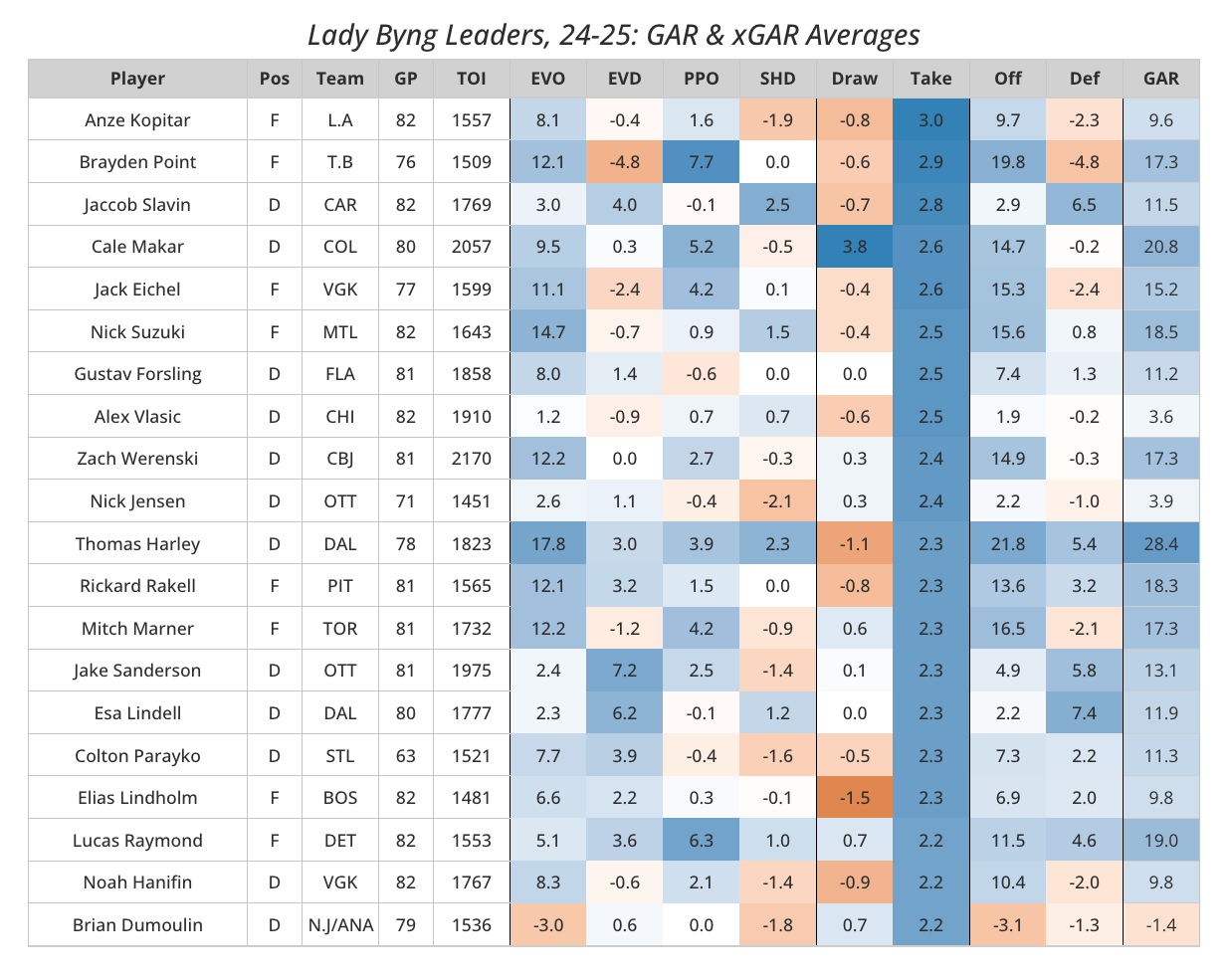
Tiers
- Anže Kopitar | Brayden Point | Jaccob Slavin | Cale Makar | Jack Eichel …
Possibly the most overlooked award among the group, we like to evaluate this since it provides a very interesting group of players. The Lady Byng is awarded “to the player adjudged to have exhibited the best type of sportsmanship and gentlemanly conduct combined with a high standard of playing ability.” Historically, this usually means the player who takes the least amount of penalties (or in our case, adds the most value among all skaters by not taking penalties). This definition is by far the most subjective, but I think it’s fair to replicate how most of the writers define this award through their votes and sort it this way. This season, Anže Kopitar takes our number 1 spot followed closely by Brayden Point and the perennial Lady Byng contender Jaccob Slavin.
Interestingly, I think this method also gives a group of players that fulfill the second “high standard of playing ability” criteria. For various reasons that I don’t have enough time to dig into now (maybe a good article idea in the future), there tends to be a high correlation between players with good penalty value and overall value. The obvious explanation for this is that “good” players tend to ensure their team has the puck or efficiently forces the opposing team to surrender the puck while they’re on the ice. By this logic, they often are not in a position where they need to over-extend to get the puck back and force the other team to over-extend when they’re on the ice. Either way, the list above includes several players who are mentioned elsewhere in this article, and several who have already won. This would be Kopitar’s third Lady Byng.
Vezina
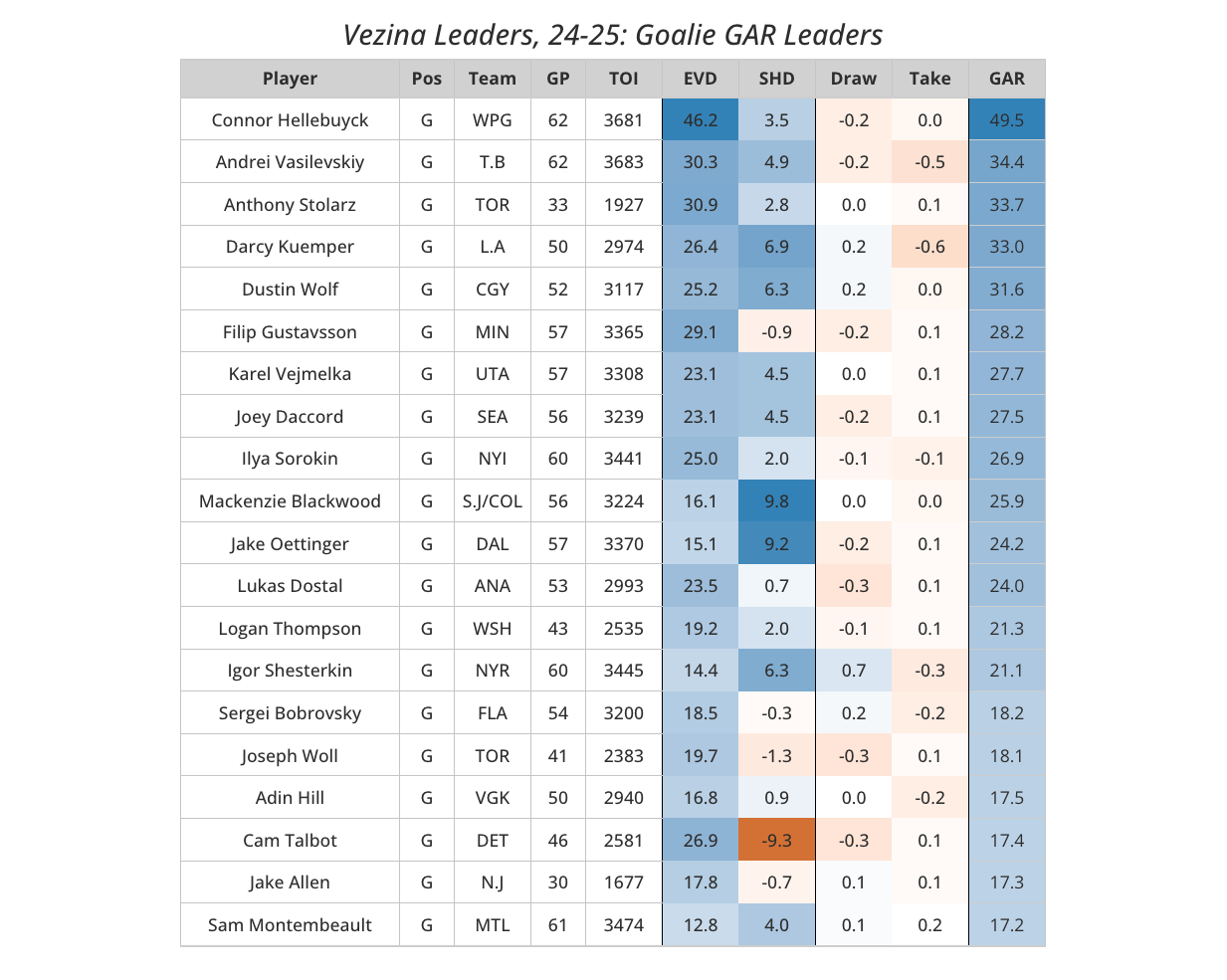
Tiers
- Connor Hellebuyck
- Andrei Vasilevskiy | Anthony Stolarz | Darcy Kuemper | Dustin Wolf
- Filip Gustavsson | Karel Vejmelka | Joey Daccord
This one is going to Hellebuyck – it may be unanimous (it probably should be). What a season from the American netminder in Winnipeg. Hellebuyck is now 2nd in career Goalie GAR since ‘07-08 (his first season was ‘15-16). He’s been remarkably consistent throughout his career and already one of the greatest goalies to ever play in the NHL. As a lock for the Vezina this year, he’ll be the first goalie to win the award in back-to-back seasons since Martin Brodeur in ‘06-07/’07-08 (he also won it in back-to-back seasons a few years before).
Now that we’ve gotten the easy part out of the way, let’s get to the others… We already covered Dustin Wolf so we’ll skip him, but we have Vasilevskiy and Stolarz basically tied in our second spot (mind you, Stolarz has only played 33 games so that’s pretty impressive – although goalies playing a lot of games often leads to worse total value added so take that with a grain of salt). It’s not necessarily surprising given his great season with Florida last year, but he’s arguably been the main reason why the Leafs are going to finish first in the Atlantic. Kuemper and Gustavsson round out the top goalies in this list. I’m running out of things to say since this award is already decided.
—
That’s our NHL Awards article! We set out to do a little post to quickly expand on our Twitter/Bluesky threads, and now we’re almost at 3000 words. Neither of us has any idea how to keep things short – I can’t remember the last time we posted anything anywhere that was shorter than this. This is just a fact of life that we need to accept. Anyway, let us know what you think. Do you have any suggestions for better ways to evaluate the NHL awards? Did we miss someone? Are you still reading this? Thank you. We love you. Get ready for our playoff previews in a week (holy sh*t those are due in like five days). Marcus Foligno for Selke 2025.
